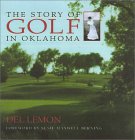The Story of Golf in Oklahoma
Somewhere along the way I’ve managed to visit at least 28 states, and play golf in 12 of them. Both coasts are well-represented, with most of the missing states in the middle of the country.
With this book, Del Lemon has given me a wealth of reasons to add Oklahoma to the list, especially for its golf.
Lemon asked me to review his work, and I must admit that the idea of reading a history of OK golf would not have occurred to me otherwise.
Now, I’m glad he asked.
I enjoy reading golf histories, both about the courses and the golfers who played them. Lemon’s extensive bibliography and footnotes (this is, after all, published by the University of Oklahoma press) includes many such references, including the invaluable works of Al Barkow and Herbert Warren Wind.
Lemon also conducted significant original research, which one would expect from an experienced, award-winning golf columnist from Texas, the Sooner State’s big sister to the south.
The opening chapter describes the humble beginnings of golf west of the Mississippi, and Oklahomans’ first faltering steps to add the sport to the recreational opportunities in the young territory. This chapter and other portions provide a detailed look at the development of several native course architects who brought honor and distinction to their profession, especially Perry Maxwell.
The book delves deeply into Oklahoma tournament histories as well, and not simply the more famous USGA events held there. Lemon shows how other events such as the Oklahoma Open helped the careers of many golfers, such as Tony Lema and Jack Nicklaus.
He also describes the relatively accepting atmosphere of Oklahoma golf events in the middle of the last century, especially for black golfers, when skilled players such as Charlie Sifford and Bill Spiller could not obtain PGA membership.
The segments on women golfers were also well done. From Babe Zaharias, to Nancy Lopez, to less well known but accomplished players like Kathy Baker Guadagnino, Lemon explains how the State’s universities and clubs provided an atmosphere for women players to flourish.
The history of men’s college golf in Oklahoma is equally thorough. The rivalries that continue today among the golf teams at Tulsa, Oklahoma State, and the University have a long history. Lemon’s treatment of this segment and his occasional references to high school golf exploits reminded me of A.B. Hollingsworth’s fine novel, Flatbellies, about growing up in a small town in the state.
The book’s text is nicely supplemented by several photographs and illustrations, including golf course layouts, old publicity photos, and coverage of more recent events.
The appendices also include tournament results from several major Oklahoma events, and mini-biographies of several hundred golfers who were either born in Oklahoma or resided in the state long enough to make their mark in the state’s golf history.
If you are an Oklahoma golf fan, or have an interest in golf history, this book will be a welcome addition to your library.
Thanks, Del!
Review Date: March 23, 2002


